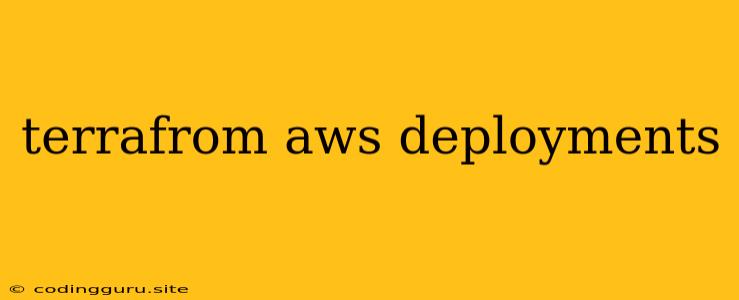Terraform: Your Gateway to Streamlined AWS Deployments
The world of cloud computing is constantly evolving, with new services and features popping up all the time. This dynamic landscape can be overwhelming, especially when you're trying to deploy and manage infrastructure on a platform like AWS. That's where Terraform comes in.
Terraform is an open-source infrastructure-as-code (IaC) tool that simplifies the process of deploying and managing your AWS resources. But how does it actually work, and what are its key benefits?
What is Terraform?
Terraform acts as a bridge between you and your cloud infrastructure. Instead of manually configuring each service in the AWS console, you can use Terraform to define your infrastructure as code in a simple, declarative format. Terraform then takes your code and translates it into the necessary API calls to create and configure your AWS resources.
Why Use Terraform?
Terraform offers a plethora of benefits for anyone working with AWS deployments. Here are a few key advantages:
- Infrastructure as Code: With Terraform, you can define your AWS infrastructure in code, making it version-controlled, reproducible, and easier to share with your team. This is crucial for maintaining consistency and avoiding configuration drift.
- Automation: Terraform automates the entire deployment process, from provisioning resources to setting up configurations. This eliminates manual errors and saves you valuable time.
- Consistency and Scalability: Terraform ensures consistent deployments across environments, making it perfect for scaling your infrastructure.
- Improved Collaboration: Terraform allows you to easily share infrastructure code with your team, leading to better collaboration and a more unified approach to deployment.
- Cost Optimization: Terraform lets you define and manage your AWS resources more effectively, which can lead to cost savings in the long run.
Getting Started with Terraform
Here's a step-by-step guide to start using Terraform for your AWS deployments:
- Install Terraform: Download and install the appropriate Terraform binary for your operating system from the official website.
- Configure AWS Credentials: Set up your AWS credentials by creating a configuration file (
~/.aws/credentials) or environment variables. You can also use the AWS CLI for authentication. - Create a Terraform Configuration File: Define your AWS infrastructure using the Terraform configuration language (HCL) in a file with the
.tfextension. - Initialize Terraform: Run the
terraform initcommand to initialize the working directory and download necessary plugins. - Plan your Deployment: Use
terraform planto generate an execution plan that shows the changes Terraform will make to your infrastructure. - Apply the Changes: Execute
terraform applyto apply the changes defined in the plan. This will create or update your AWS resources.
Example: Deploying an EC2 Instance with Terraform
Let's take a look at a simple example of deploying an EC2 instance using Terraform.
# Configure the AWS provider
provider "aws" {
region = "us-east-1"
}
# Create an EC2 security group
resource "aws_security_group" "allow_ssh" {
name = "allow_ssh"
description = "Allow SSH access"
ingress {
from_port = 22
to_port = 22
protocol = "tcp"
cidr_blocks = ["0.0.0.0/0"]
}
egress {
from_port = 0
to_port = 0
protocol = "-1"
cidr_blocks = ["0.0.0.0/0"]
}
}
# Create an EC2 instance
resource "aws_instance" "web_server" {
ami = "ami-082c305693718e0ce"
instance_type = "t2.micro"
key_name = "my-key-pair"
tags = {
Name = "Web Server"
}
security_groups = [aws_security_group.allow_ssh.id]
}
This code snippet defines a security group that allows SSH access and an EC2 instance with a specific AMI, instance type, and key pair. You can customize this code to meet your specific requirements.
Beyond Basic Deployments: Advanced Features
Terraform offers many advanced features that can help you manage complex AWS deployments:
- Modules: Break down your infrastructure into reusable modules for better organization and maintainability.
- Variables: Define variables for dynamic configuration, allowing you to use the same code for different environments.
- Outputs: Retrieve information about your deployed resources, such as IP addresses or security group IDs.
- Data Sources: Fetch data from existing AWS resources and use it in your configurations.
- State Management: Terraform tracks your infrastructure state and can automatically update it after deployments.
Conclusion
Terraform is a powerful tool for anyone deploying and managing infrastructure on AWS. It allows you to define your resources as code, automate deployments, and improve consistency and collaboration. As you delve deeper into the capabilities of Terraform, you'll discover even more ways to streamline your AWS workflows and optimize your cloud infrastructure.
